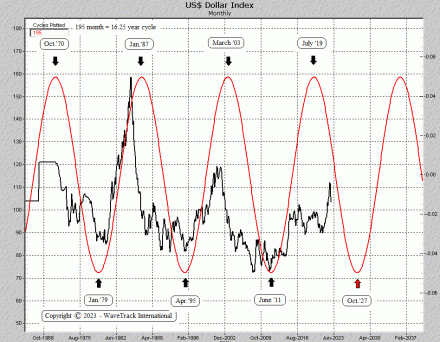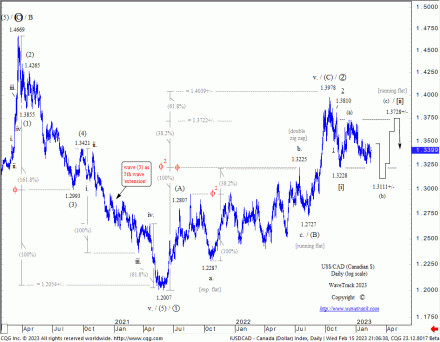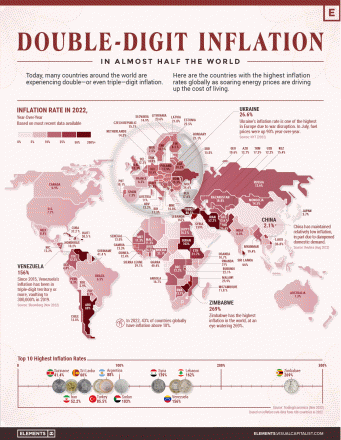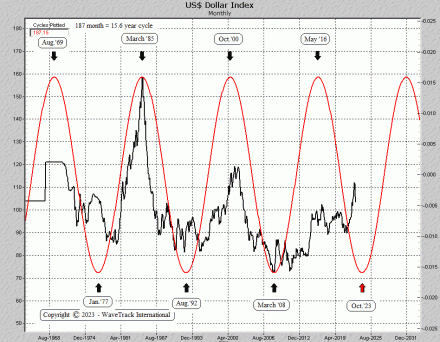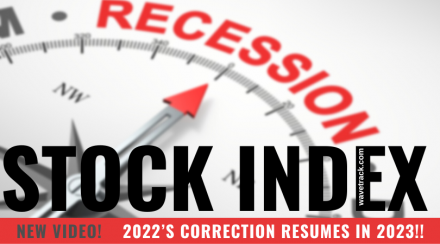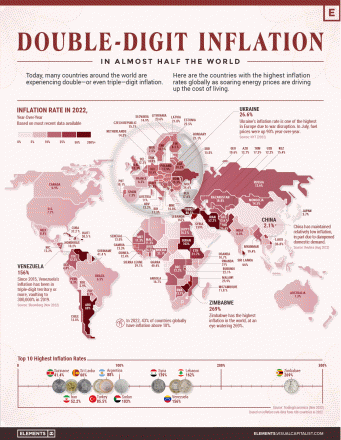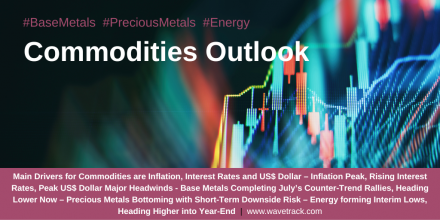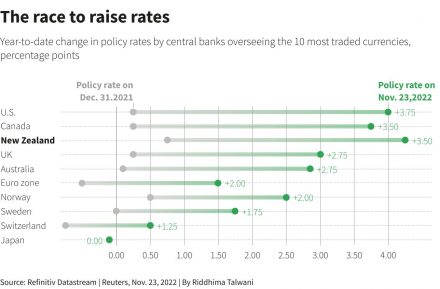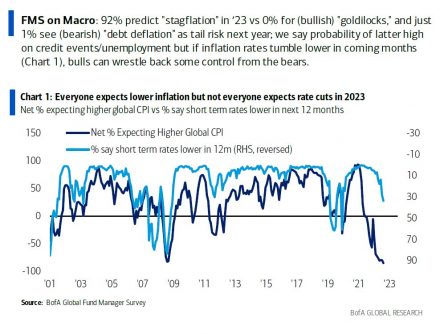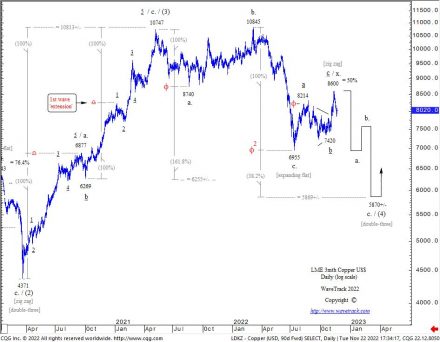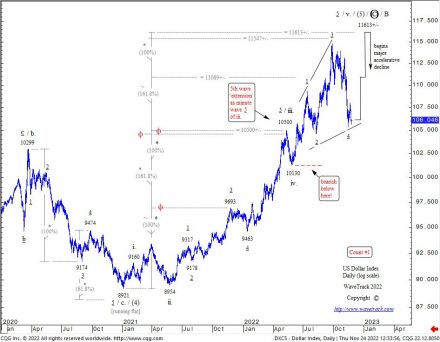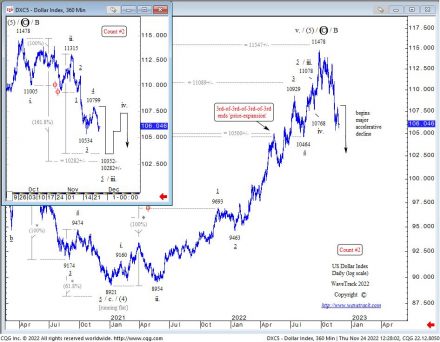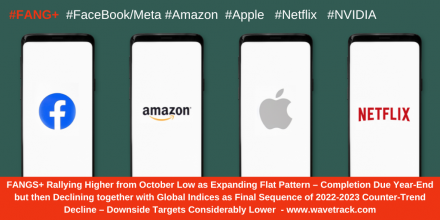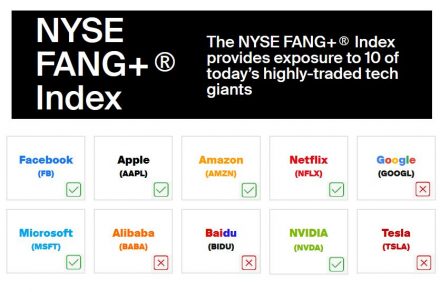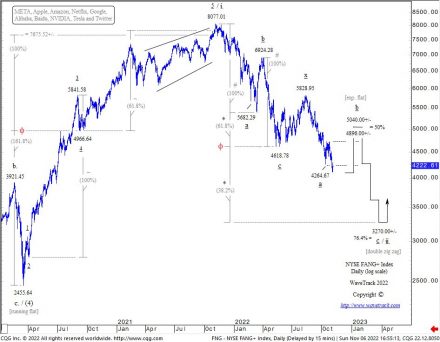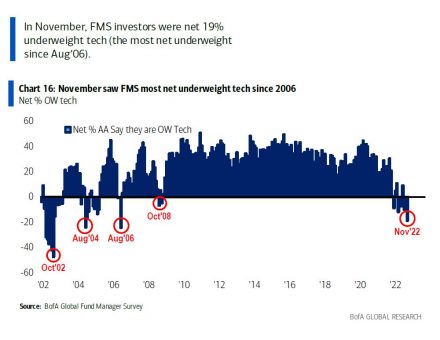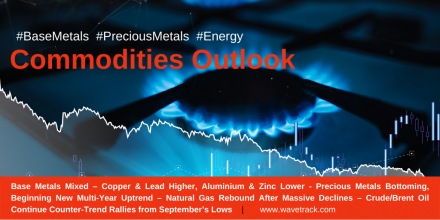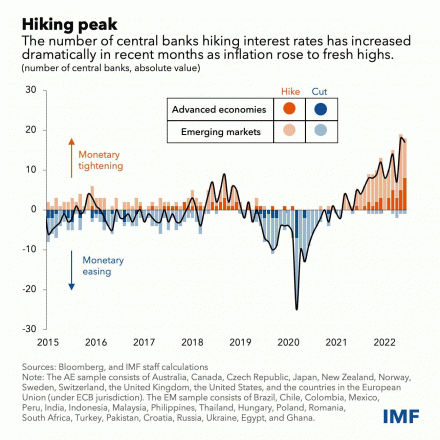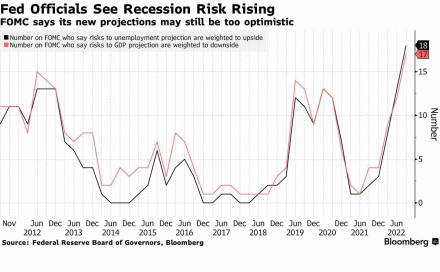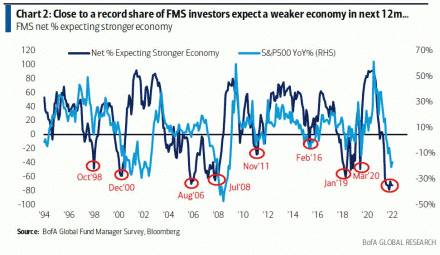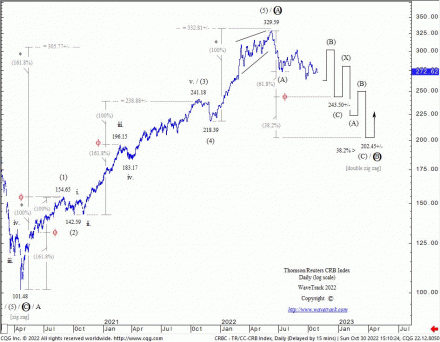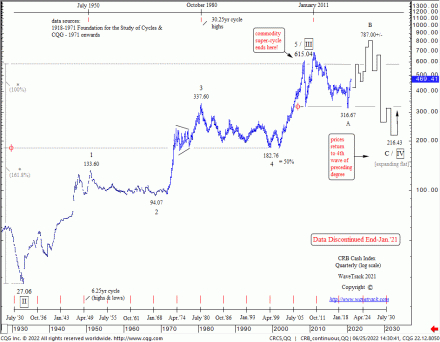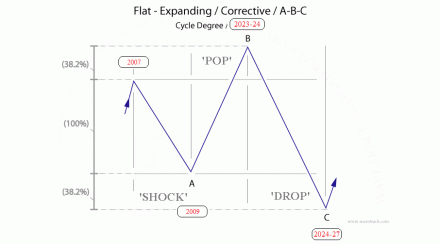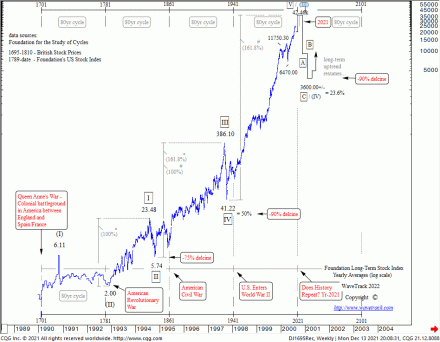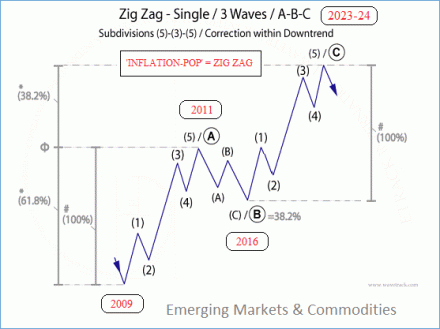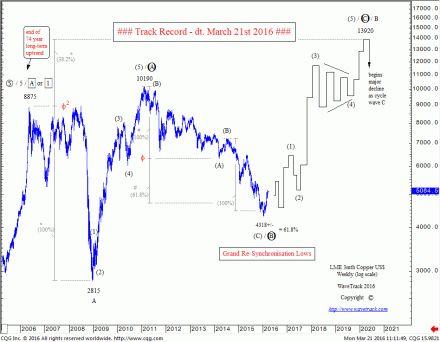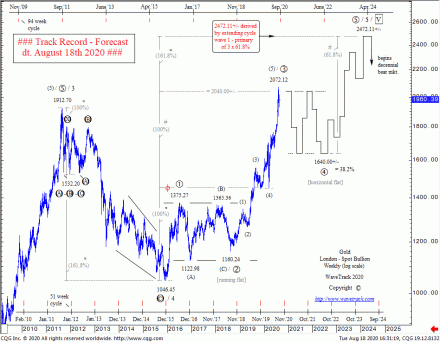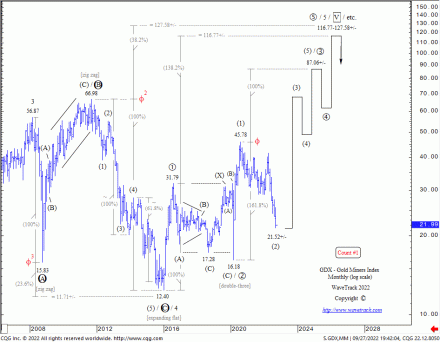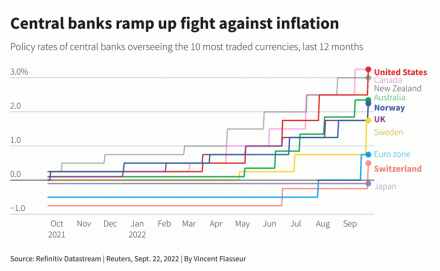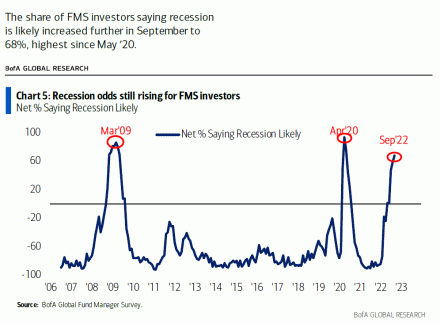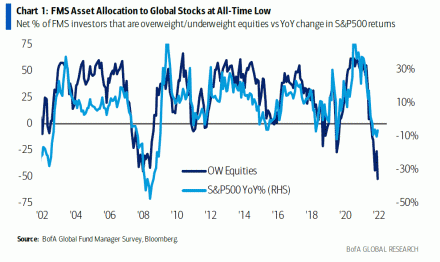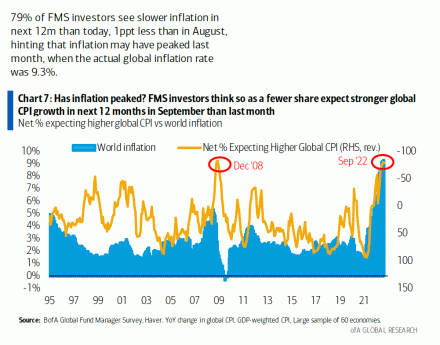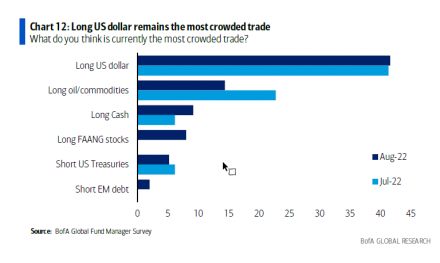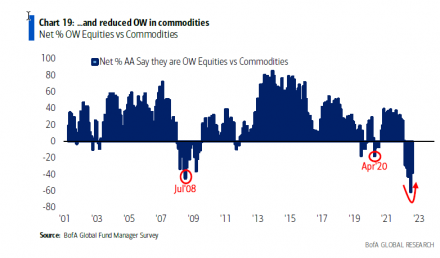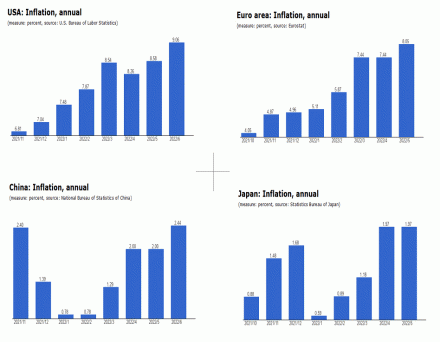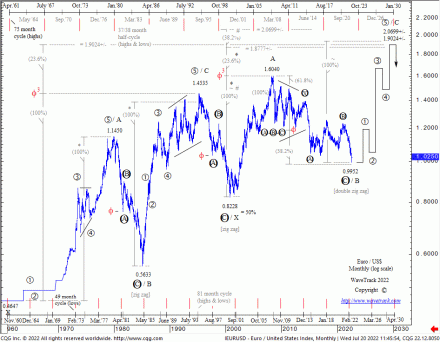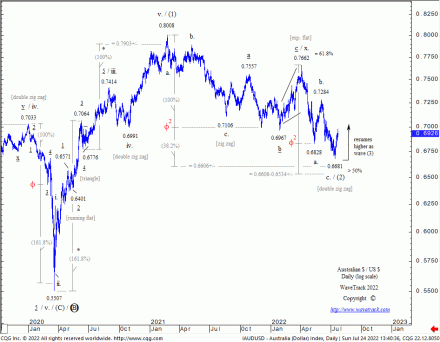New Currencies + Interest Rate Video Outlook 2023
by WaveTrack International| February 25, 2023 | No Comments
Currencies and Interest Rate Video Outlook 2023
Inflation Ticks Higher before Resuming Lower – Short but Sharp Recession for 2023
Currencies and Interest Rates Highlights
Yield Inversion Normalises into Steeper Trajectory
Bank of Japan Raise JGB Limit
Outlook Preview Currencies
• Central Banks (CBs) have overestimated the impact from 6-month declines in headline Consumer Price Index (CPI) prices – whilst CB’s are still maintaining their interest rate-hiking cycles, they’ve slowed the pace as they approach perceived ceilings – market participants have expected a Fed-Pivot but this is unlikely right now – Elliott Wave analysis expects further interest rate rises through Q1/2 ’23 before a collapse lower afterwards as risk-assets sell-off triggering a short but sharp recession for 2023.
• The long-term outlook for the US$ dollar index remains very bearish – the year-1985 decline from record highs of 164.72 began a cycle degree A-B-C zig zag correction – wave A ended at 85.33 in 1987 and wave B only recently, into the Sep.’22 high of 114.78 – wave C has since begun a primary degree five wave impulse decline where ultimate downside targets remain towards 51.18+/-. That’s a depreciation of -55% per cent before the end of the decade.
Outlook Preview – Interest Rates
• The 60-year cycle in Corporate AAA Bond Yields formed a major low in year-2011 which ordinarily translates into a new sustained half-cycle uptrend of 30+/- years – but the COVID-19 coronavirus pandemic forced more monetary accommodation from central banks, prolonging the previous 30-year cycle downtrend even longer – but the March ’20 lows are finally secure, confirming a new 30+ year uptrend for interest rates has begun.
• Central Banks & Inflation – In last year’s mid-year report, we forecast an interim high for inflation and a pullback lasting several months, maybe longer. That scenario has unfolded to plan – U.S. headline CPI has pulled lower from last June’s high of 9.1% to 6.4% in Jan.’23 fueling market expectations of higher risk-assets, i.e. stocks and commodities on a growing belief that inflation has peaked, Central Banks will deliver a soft (economic) landing, consumers adapting to higher costs and a China reopening. But Elliott Wave analysis suggests this is too optimistic – inflationary pressures are expected to tick higher during the next 2-3 months causing a re-think from the consensus Fed-Pivot/soft-landing forecasts – rather, Central Banks are forced to turn more hawkish, prolonging the current interest rate hiking cycle, i.e. higher-rates-for-longer. This triggers a risk-asset collapse which later turns yields lower but not before higher-highs during the next 2-3 months.
Currencies – US$ Dollar Index – Long-Term Cycle
The origin of the US$ dollar goes back to the 1660’s when the Spanish Real-de-a-Ocho, also known as the piece of eight, is a silver coin worth eight Spanish Reales. It was minted in the Spanish Empire following a monetary reform in 1497 with content 25.563 g = 0.822 oz t fine silver (Quarterly Forecast chart in our latest report!).
The amazing thing about the price development of the Spanish dollar into the American dollar is the way in which it unfolds over many centuries into a perfectly formed Elliott Wave impulse pattern consisting of five waves from the all-time-low of the American Civil War low of 1864 into the eventual peak of 1985. That five wave expanding impulse ending on a quarterly closing price of 149.46 (intraday at 164.72) explains why the dollar has been declining ever since reaching this peak – because the completion of a five wave uptrend must next be compensated by a three wave correction, in this case, labelled as a cycle degree A-B-C zig zag which is still unfolding to this day.
Cycle wave B ended last September ’22 at 114.78 having completed a primary degree running flat pattern from the Oct/’87 low of 85.33. Extending wave A (including the lower-low to 70.70 of wave B) by a fib. 38.2% ratio projects wave C down to 51.18+/- within the next several years. Such a decline would emulate wave A’s decline which took 2½ years to complete – that’s a dollar depreciation of -55% per cent with a date for completion in March ’25.
We think it will take a little longer basis the 195-month, 16.25-year cycle which depicts the next major low around Oct.’27 – see fig #216.
Preview Currencies – USD vs. CAD
US$/CAD Canadian dollar ended cycle wave B at 1.4040 (146.69) into the pandemic high and is now trending lower as cycle wave C during the next several years. Shorter-term, the outlook is unclear with primary wave 2’s rally from the June ’21 low of 1.2007 ending into the Oct.’22 high of 1.3978 alongside a US$ dollar index peak – but so far, no five wave impulse decline to confirm the new downtrend. See fig 253.
Year of Opportunity and Vigilance – Be Prepared
Our EW-team worked hard to put this information together in a way that is comprehensive to ensure that you are prepared for the major FX moves to come in 2023 and beyond. Check out the table of contents below and if you are trading Currencies – don’t miss it!
We invite you to take this next step in our financial journey with us – video subscription details are below – just follow the links and we’ll see you soon!
Most sincerely,
Peter Goodburn
Founder and Chief Elliott Wave Analyst
WaveTrack International
What you get
Contents: 150 charts | VIDEO DURATION: nearly 2 hours 44 mins.
The contents of this CURRENCIES & INTEREST RATES VIDEO include Elliott Wave analysis for:
Forex (151 charts):
• US CPI
• US PCE
• US$ Index + Cycles
• Euro/US$ + Cycles
• Stlg/US$
• US$/Yen
• US$/CHF
• US$/NOK
• US$/SEK
• AUD/US$
• US$/CAD
• NZD/US$
• Euro/Stlg
• Euro/Yen
• Euro/CNY Renminbi
• Stlg/YEN
• Stlg/AUD
• Stlg/ZAR
• AUD/YEN
• AUD/CNY Renminbi
• AUD/NZD
• Asian ADXY
• US$/Renminbi
• US$/KRW
• US$/SGD
• US$/INR
• US$/TWD
• USD/THB
• US$/MYR
• US$/IDR
• US$/PHP
• USD/BRL
• USD/RUB
• US$/ZAR
• US$/MXN
• US$/TRY
• US$/PLZ
• Bitcoin
• Ethereum
Interest Rates (53 charts):
• US10yr Real Yield
• US30yr Yield + Cycles
• US10yr Yield + Cycles
• US5yr Yield
• US2yr Yield
• US2yr-10yr Yield Spread
• US10yr-30yr Yield Spread
• 3mth EuroDollar-US10yr Yield Spread
• Comparison US10-DE10yr vs S&P 500
• US10yr TIPS Break Even Inflation Rate
• US10-DE10yr Yield Spread
• DE10yr Yield
• ITY10yr Yield
• Italy10-DE10yr Yield Spread
• Australia 10yr Yield
• Japan 10yr Yield
How to buy the Forex + Bonds Video Outlook 2023
Simply contact us @ services@wavetrack.com to buy the CURRENCIES + INTEREST RATES Video Outlook 2023 for USD 49.00 (+ VAT where applicable) or alternatively our Triple Video Offer for USD 99.00 (+ VAT where applicable) – Review the content of WaveTrack Stock Indices Video PART I here and the Commodities Video PART II here.
*(additional VAT may be added depending on your country – currently US, Canada, Asia have no added VAT but most European countries do)
We’re sure you’ll reap the benefits – don’t forget to contact us with any Elliott Wave questions – Peter is always keen to hear you views, queries and comments.
Visit us @ www.wavetrack.com
New Commodities Video Outlook 2023
by WaveTrack International| January 23, 2023 | No Comments
Commodities Video Outlook 2023 – ‘Let’s review the main drivers for COMMODITY prices – Inflation, Interest Rates, the likelihood of an Economic Recession and trends in the US$ Dollar’
We’re pleased to announce the publication of WaveTrack’s annual Triple Video Outlook 2023 of medium-term ELLIOTT WAVE price-forecasts. Today’s release is PART II, COMMODITIES – Part I was released last month and Part III will be published in late-February / beginning of March 2023…
• PART I – STOCK INDICES – out now!
• PART II – COMMODITIES – out now!
• PART III – CURRENCIES & INTEREST RATES – coming soon!
Commodities Forecast Highlights 2023!
Commodities Underperformers vs. Outerperformer’s for 2023
Commodities tied to the fluctuations in the global economic cycle are preparing for another downturn during the first-half of 2023. In many cases, corrective declines that began mid/late-2021 or early-2022. This depended greatly on the specific commodity to remain incomplete with further declines forecast this year, in 2023. Recession fears have since been diluted in January’s optimism, but downside risks remains.
Base Metals like Copper were initially down in 2022 by -35% but rallied higher from July’s low by +33% per cent. Eroding those earlier losses. Prices are set to decline again though, from current levels.
Energy markets which were big outperformers in 2022 are also expected lower this year. Crude/Brent oil are expected to see some of the biggest declines together with benchmark XLE and XOP ETF’s. These declines can pull prices down by -40% per cent through the first-half of the year.
In contrast, Precious Metals bottomed in September ’22 having undergone a successful counter-trend completion over the last two years. Gold, Silver, Platinum and Palladium are all set to outperform and trend higher whilst industrial commodities decline. Whilst 2-year uptrends are underway, pockets of downward corrections are expected to mirror the US$ dollar’s movements. Find out more amazing details in our Elliott Wave Commodities Video 2023!
Main Drivers for Commodity Prices
Commodities main drivers for this year remain with existing inflationary trends, interest rates, the risk of an economic recession and direction in the US$ dollar.
Double-digit inflation in some developing economic regions of the world has resulted in cap-ex reductions in key commodity areas. Especially, in developing nations, high single-digit inflation has increased fears of a recession this year, in 2023 – see fig #96. Fund managers were unanimous late last year (2022) that persistent inflationary pressures would trigger an economic downturn this year although declines in U.S. CPI from the June ’22 peak of 9.1% to 6.5% has given way to January’s optimism for a mild recession.
‘Goldilocks’ moment?
Goldman Sachs analysts are epitomising that change into more optimistic sentiment. They say that commodities have the strongest outlook of any asset class in 2023, with a perfect macroeconomic environment and critically low inventories for almost every key raw material. They said that demand in China is starting to rebound and there’s insufficient investment in supply, meaning the year as a whole will be a ‘Goldilocks’ moment for rising prices.
The Federal Reserve dot-plot
The Federal Reserve dot-plot suggests the fed-funds rate will end up around 5.0% per cent. February’s next meeting suggests a slowing down in the pace of increases with the market expecting only 0.25% rate hike. Even so, rising rates remain in the background. The long-end of the interest rate curve, ten-year treasuries and bunds traded in Europe completed counter-trend 4th wave corrections into December’s lows. They’re already showing signs of heading higher. This is really important because if interest rates are set to resume higher, then it will be the major pain trade of the year because just about every bond trader is currently positioned for lower rates, not higher.
The US$ Dollar
One of the main contributing factors that’s expected to drive commodity prices higher over the next several years into an ‘inflation-pop’ peak is the weakening of the US$ dollar. There’s a distinct 15.6-year cycle recurrence for the US$ dollar index which has signalled the various peaks and troughs over the past several decades – see fig #105.
Commodities Video Outlook 2023
This video is Part II and we’ll be taking a look at over 100 individual commodity contracts and cycles within three main sub-sectors, Base Metals, Precious Metals, Precious and Base Metal Miners and Energy.
The central themes we’ll be discussing in this video include amongst those mentioned before an update of inflation-sensitive commodities like Food and Energy including ETF’s like the DB Agriculture Fund, XLE and XOP. Furthermore, we’re taking a look at some strategic metals like Iron Ore, Uranium and Rare Earth ETF’s and a few related equities. And much more…
This is WaveTrack’s state of the art video –only available twice a year– if you are trading commodities this is a must have.
Sincerely,
Peter Goodburn & EW-team
Commodities Video Outlook 2023 Part II/III
Contents: 113 charts
Time: 2 hours 24 mins.
• US CPI
• Food and Agriculture Index
• DB PowerShares Agriculture Fund
• US Dollar index + Cycles
• CRB-Cash index + Cycles
• Copper + Cycles
• Aluminium
• Lead
• Zinc
• Nickel
• Tin
• Iron Ore
• Uranium
• Rare Earths
• BHP-Billiton
• Freeport McMoran
• Antofagasta
• Anglo American
• Glencore
• Rio Tinto
• Vale
• Gold
• Gold-Silver Ratio
• Silver
• Platinum/Silver Ratio
• Platinum
• Palladium/Gold Ratio
• Palladium/Platinum Ratio
• Palladium
• GDX Gold Miners Index
• Newmont Mining
• Amer Barrick Gold
• Agnico Eagle Mines
• AngloGold Ashanti
• XAU Gold/Silver Index
• Fresnillo Silver
• Crude Oil + Cycles
• Brent Oil
• Gasoline RBOB
• Natural Gas
• TTF Natural Gas
• XLE Energy SPDR
• XOP Oil and Gas Index
How can you purchase the video?
1. Contact us @ services@wavetrack.com and ask for a PayPal payment link(please state if you like to purchase the Commodities Single video for USD 49.00 + VAT* or the Triple Video for USD 99.00 +VAT*?).
2. Additionally, to PayPal we now offer as well payment via credit card payment link
*(additional VAT may be added depending on your country – currently US, Canada, Asia have no added VAT but most European countries do)
We’re sure you’ll reap the benefits – don’t forget to contact us with any Elliott Wave questions – Peter is always keen to hear you views, queries and comments.
Visit us @ www.wavetrack.com
We’re sure you’ll reap the benefits. Don’t forget to contact us with any Elliott Wave questions. Our EW-team is always keen to hear your views, queries, and comments.
Visit us @ www.wavetrack.com
Stock Indices Video Outlook 2023
by WaveTrack International| December 28, 2022 | No Comments
Stock Indices Video Outlook 2023
2022’s CORRECTION RESUMES IN 2023!!
Highlights
2022’s CORRECTION RESUMES IN 2023!!
This exact time last year (December 2021), Elliott Wave analysis identified the end of 1st waves within post-pandemic five wave uptrends, the final bull market of the greater secular-bull uptrend that originated back to the financial-crisis lows. A deep 2nd wave correction was forecast for 2022, predicting decline of between minus -30% to -40% per cent.
At the same time, 70% per cent of mainstream investment brokers and analysts were telling their clients the benchmark indices would rise in 2022 between 5% to 15% per cent. So how did we do? It turns out that the benchmark S&P 500 declined from its Jan.’22 high into October’s low by minus -28% per cent and the Nasdaq 100 from its Nov.’21 high by minus -38% per cent! Lucky guess? – absolutely not, but down to the application of what R.N. Elliott described by applying the principle of ‘Nature’s Law’ – action/reaction as a Universal Principle. So what can we expect in the coming year, for 2023?
Double-Digit Inflation
Rising inflationary pressures continued to dominated financial markets during 2022 with U.S. headline acceleration peaking into a mid-year high of 9.1% whilst elsewhere, in Europe, peaking at 10.6% in October.
Geopolitical tensions are triggering high energy costs. While supply-side disruptions are also distorting consumer prices. The end result is that almost half of countries worldwide are seeing double-digit inflation rates or higher – see fig #1 (courtesy of elements.visualcapitalist.com).
With new macroeconomic forces shaping the global economy, the infographic shows countries with the highest inflation rates (using data from Trading Economics). As the table below shows, countless countries are navigating record-high levels of inflation. Some are even facing triple-digit inflation rates. Globally, Zimbabwe, Lebanon, and Venezuela have the highest rates in the world.
As price pressures mount, 33 central banks tracked by the Bank of International Settlements (out of a total of 38) have raised interest rates this year. These coordinated rate hikes are the largest in two decades, representing an end to an era of rock-bottom interest rates. Where do we go from here? Find out more in our latest Elliott Wave Stock Indices Video Outlook 2023!
New Stock Indices Video Outlook 2023 – PART I/III
This STOCK INDICES Video Outlook 2023 is like nothing you’ve seen anywhere else in the world. It’s unique to WaveTrack International, how we foresee trends developing through the lens of Elliott Wave Principle (EWP) and how its forecasts correlate with Cycles, Sentiment extremes and Economic data trends.
We invite you to take this next step in our financial journey with us – video subscription details are below – just follow the links and we’ll see you soon!
Most sincerely,
Peter Goodburn
Founder and Chief Elliott Wave Analyst
WaveTrack International
Contents Stock Indices Video Outlook 2023
Charts: 95 | Video: 2 hours 11 mins.
CONTACT US NOW VIA EMAIL – SELECT YOUR PACKAGE
Single Video – *$49.00 – PART I Stock Index Video Outlook 2023 (Decmeber ’22) or send us an email to services@wavetrack.com
Triple Package offer – *$99.00 (saving 33%)! – PART I – PART II – PART III (January – February ’23)
*(additional VAT may be added depending on your country – currently US, Canada, Asia have no added VAT but most European countries do)
PARTS II & III will be available in a few weeks’ time – we’re working on it!
HOW CAN YOU RECEIVE THE VIDEO FORECAST?
To receive your VIDEO UPDATE please click here to contact us.
– Please state if you wish to purchase the SINGLE VIDEO – Stock Index Video Outlook 2023 for USD *49.00 and send us an email to services@wavetrack.com?
– Or opt for the TRIPLE PACKAGE for USD *99.00 in total?
– Next we will send you a PayPal payment request and provide you with the video link & PDF report once payment is confirmed. Please know the reply can take up to 6 hours. But rest assured we will give our best to provide you with the information as soon as possible!
*(additional VAT may be added depending on your country of residence. Currently, the US, Canada, Asia have no added VAT but most European countries do)
We’re sure you’ll reap the benefits – don’t forget to contact us with any Elliott Wave questions – Peter is always keen to hear your views, queries, and comments.
Visit us @ www.wavetrack.com
Elliott Wave Commodities Update
by WaveTrack International| November 29, 2022 | No Comments
Main Drivers for Commodities are Inflation, Interest Rates and US$ Dollar – Inflation Peak, Rising Interest Rates, Peak US$ Dollar Major Headwinds – Base Metals Completing July’s Counter-Trend Rallies, Heading Lower Now – Precious Metals Bottoming with Short-Term Downside Risk – Energy forming Interim Lows, Heading Higher into Year-End
Commodities Prices – 3 Main Drivers
The main drivers for commodities prices are inflation, interest rates and the US$ dollar.
Central Banks have maintained their aggressive pace of interest rate hikes with one or two exceptions. The Reserve Bank of Australia pulled back on its 50bps basis point incremental increased from June to September with only 25bps basis points in the last two meetings. The Reserve Bank of Canada hiked rates by 100bps basis points last July but has since pulled back to 50bps increases in October. The U.S. Federal Reserve have maintained their 75bps basis point increases since June but is hinting it may slow down to 50bps in the next December meeting. Inflation pressures have eased off a little in the U.S.. This is giving rise to peak inflation expectations. However, the big question related to commodity prices is whether this year’s hikes have already dented the world’s economic growth prospects? See fig #1.
CPI/Eurozone Inflation
In Bank of America’s latest Global Fund Manager Survey, a massive 92% per cent of fund managers predict stagflation in 2023 – see fig #2 . That means persistent inflationary pressures but at the same time economic stagnation. Central Banks are set to keep hiking during the first quarter of next year in an attempt to bring inflation down. Even if this means sacrificing the global economies. And this combined with more COVID lockdowns in China is creating strong headwinds for commodities into year-end though Q1 2023.
Commodities and Energy
We can see the effect in Base Metals like Copper – see fig #3. Prices have declined a lot over the past year. Precisely, down -35% per cent into July’s low although a recovery since means it’s down now by -20% per cent. However, that’s still massive, and it hasn’t finished yet. July’s recovery has unfolded into an Elliott Wave corrective zig zag pattern ending into the mid-November high. It’s now preparing for another big downswing which is forecast ending sometime into the end of Q1 2023, or beginning of Q2. That’s confirming what most fund managers expect – stagflation.
Commodities and Energy
The energy markets are also showing big declines for Crude and Brent oil next year. Although there’s the prospect of good gains before the next declines begin. We’ll be taking a look at these contracts later.
If there’s good news on the horizon, it has to be in Precious Metals. Last month’s report identified a major low in Gold, Silver, Platinum and the Gold Miners. This is still the case. However, there are some downside risks before year-end. This is dependent on whether the US$ dollar undergoes one last push to a modest higher-high, or if September’s high has already peaked – see fig’s #4-5.
Either way, the Gold Minders have been confirmed putting in a major low and are already trending into a new multi-year uptrend – See GDX Gold Miners index fig #6.
WaveTrack’s EW-Commodities Report has been released. Get more insights about trading opportunities in our latest EW-Commodities Outlook report and video update!
FANG+ Rallying Higher from October Low
by WaveTrack International| November 16, 2022 | No Comments
FANG+ Rallying Higher from October Low as Expanding Flat Pattern – Completion Due Year-End but then Declining together with Global Indices as Final Sequence of 2022-2023 Counter-Trend Decline – Downside Targets Considerably Lower
FANG+ Rallying Higher
This month’s report updates several technology stocks which themselves are components of the FANG+ index. We’ve selected 6 FROM 10 components that best illustrate the varying divergences of trend. The analysis begins with a take on the pattern developing in the benchmark FANG+ index. And, then moving on to the equities – Amazon Inc., Apple Inc., Facebook/Meta Inc., Microsoft Corp., Netflix Inc. and finally NVIDIA Corp. See fig #1.
FANG+ Analysis from an Elliott Wave Persepective
From an Elliott Wave pattern perspective, we can order these equities into two groups. Those stocks that have already formed a major low and the second group which are set to continue this year’s declines into Q1 2023.
The Fang+ index has lost Twitter since Elon Musk’s takeover with Microsoft taking its place. The weighting is the same 10% for each equity, 10 in all equating to 100% per cent.
The Fang+ index is unfolding similarly to the Nasdaq 100 with some slight variation. Both are declining into a multi-year corrections that began from the Nov.’21 highs. These are developing into double zig zags, i.e. a-b-c-x-a-b-c – see fig #2. We already had a pretty good idea in December ’21. Note, this is almost a year ago, that 2022 would see a severe downward correction in the technology sector because the post-pandemic advance into the Nov.’21 peaks unfolded into an a-b-c zig zags. Implying this was ending the 1st wave of an ending-type diagonal with the necessity of a deep 2nd wave correction to augment the ongoing pattern development of the diagonal. These zig zags were especially evident in the Nasdaq 100 and the XLK Technology indices.
And so, the FANG+’s corrective decline from the Nov.’21 high of 8077.01 completed the 1st wave of the diagonal with a double zig zag downswing declining since as a deep 2nd wave. That double zig zag remains incomplete. As a result, it forewarns of another big sell-off next year. However, during Q1 2023 but not before finishing the current counter-trend rally that began in October and due to finish in December, year-end.
FANG+ What about Apple, Microsoft and NVIDIA?
Equities that fall into this grouping where upside rallies continue until year-end but then decline rapidly during Q1 ’23 are Apple Inc., Microsoft and NVIDIA. In contrast, the others are forming major lows right now. They are set to outperform over the next several months because they’re unlikely to break below recent lows. This applies to Amazon Inc., Facebook/Meta and Netflix.
The latest Bank of America Fund Manager Survey shows the technology sector as the most underweight since 2006. We’d expect that extreme to neutralise a little with a push higher for technology into year-end. See fig #3.
Watch the latest amazing EW-Navigator video and get more insights about Technology Stocks trading opportunities US Stock Indices update!
Tags: Amazon > Apple Inc. > Meta Inc. > Microsoft Corp. > Netflix Inc > NVIDIA Corp
EW-Commodities Update
by WaveTrack International| November 3, 2022 | No Comments
Commodities – Base Metals Mixed – Copper & Lead Higher, Aluminium & Zinc Lower – Precious Metals Bottoming, Beginning New Multi-Year Uptrend – Natural Gas Rebound After Massive Declines – Crude/Brent Oil Continue Counter-Trend Rallies from September’s Lows
Natural Gas Prices – Elliott Wave Forecasts predicted the decline!
Commodities Highlight! European TTF Gas prices have declined by -72% per cent from the late-August high whilst U.S. Natural Gas prices have declined during the same time by -52% per cent. And here we are, seeing core inflationary pressures still rising!
Just today, Eurozone CPI (HICP) inflation for October has come through at an annualised headline rate of 10.7% per cent. The highest ever recorded across the Bloc. As a result, core CPI is rising too, but much lower at 5.0% per cent.
Just last week, U.S. headline CPI was annualised at 8.2%, down from June’s high of 9.1% per cent but with core rising much faster, at new post-pandemic highs of 6.6% per cent.
Inflationary Pressures and Natural Gas Conundrum
Both Europe and the U.S. central banks have blamed Food & Energy as the two key components within CPI that are responsible for elevated inflationary pressures. But if that’s correct, how is it possible for continued inflation rises whilst TTF and Natural Gas prices are plummeting? Is this just a lag? Or some other explanation?
What about Japanese Inflation?
Japan is the world’s 3rd biggest economy. They consume food and energy just like you and me. And yet inflation is only 3% per cent – why? We’re told it’s because there’s government price controls in place. E.g. an aging population with some of the world’s highest savings rates and negative interest rates implemented by the Bank of Japan. Certainly, all contributing factors. But are these able to absorb the huge energy price rises of the last 18-months? We think not. One thing’s for sure, now that TTF/Natural Gas prices have collapsed lower, we should expect inflation to come down now. If not, then data manipulation on a grand scale is where our thoughts lead to next.
How are Central Banks responding to rising Inflationary Pressures?
Right now, there’s no let up in Central Banks (CB’s) responding to inflationary pressures. Especially, with aggressive hiking cycles expected to continue through to year-end. The number of CB’s hiking have reached a new peak – see fig #1.
This is having a negative impact on sentiment in both financial markets and small businesses in western economies. Even U.S. Federal Reserve officials are recognising the current pace of interest rate increases are likely to impact growth prospects, even causing a recession – see fig #2.
Commodities and the Bank of America Fund Manager Survey
In the latest Bank of America Fund Manager Survey, close to a record percentage of fund managers expect a weaker economy in the next 12-month period – see fig #3. That’s an incredible number because it surpasses bearish sentiment lows of the pandemic, the financial crisis and the post-dot-com crash lows of 2002. In all cases though, a silver lining in the cloud can be found. Notice how on each occasion of these previous lows, the benchmark S&P 500 begins a new bull market uptrend between 0-12 months afterwards.
That’s very interesting when we also take a look at how Commodity prices fit into the picture. The current extremes of economic pessimism is interpreted as a contrarian bullish signal within the next 0-12 month period. This certainly fits into the overall picture we see in the Elliott Wave structure of both Base Metals and Energy prices.
Commodities and the CRB Index
The CRB-Reuters/Jefferies index illustrates the point – where the post-pandemic advance has unfolded into a five wave impulse pattern from 101.48 finishing last June at 329.59 – see fig #4.
It has since begun a counter-trend downswing, shown unfolding into a corrective double zig zag pattern. This is set for a rebound higher for a month or so, but then continuing its decline until downside targets are reached into the end of Q1 2023, around levels of 202.45+/-. That’s another -25% per cent lower than today’s price levels – it’s already dropped -20% per cent so far this year.
Declines of another -25% per cent are mostly correlated to the Energy markets. Base Metals have already completed most of their corrective declines although there’s still more downside risk too. The exciting area for commodities is precious metals. These are forming major lows with small downside risk this month, New multi-year uptrends are set to begin.
Watch the latest amazing EW-Commodities video and get more insights about s trading opportunities in our latest EW-Commodities Outlook report and video update!
‘SHOCK-POP-DROP’ & ‘INFLATION-POP’ Explained
by WaveTrack International| October 7, 2022 | No Comments
‘SHOCK-POP-DROP’ & ‘INFLATION-POP’Explained!
Almost all commodities ended super-cycle uptrends around the year’s 2006-2008. We define the super-cycle uptrend not from the 1999 lows as is generally considered in the financial industry but from the ‘Great Depression’ lows of 1932. This is because most commodities reached all-time lows at that time. Even lower than levels traded several hundred years earlier and this provides a strong basis for historical Elliott Wave analysis. The subsequent uptrend from the 1932 low unfolded into a five wave impulse pattern into the 2006-08 highs, for benchmarks like the CRB-Cash (CCI) index, Copper and Crude oil – see fig #1.
All price action following those peaks in Commodities around 2006-08 is part of a rebalancing correction to the completion of the Super-Cycle uptrend. This correction is forecast unfolding over the next two decades. Perhaps even a little longer with declining prices over that term. In Elliott Wave terms, the correction can only unfold into three types of pattern or categories, Zig Zag, Flat or Triangle. So far, there’s evidence that confirms a Flat or specifically, an Expanding Flat pattern is taking shape. It consists of three main price-swings, labelled A-B-C subdividing 3-3-5. This is assigned the term ‘Shock-Pop-Drop’ – see fig 2.
‘SHOCK-POP-DROP’
The first ‘SHOCK’ phase develops during the financial-crisis sell-off which comes as a complete surprise to financial markets. The second ‘POP’ phase incites recovery, triggers Central Banks (CB’s) to begin an unprecedented act of Quantitative Easing (QE) forcing asset prices higher but later, inducing Rising Inflationary Pressures until the bubble finally bursts. We’ve specifically termed this the ‘INFLATION-POP’ (we’re experiencing this right now!). That leads to the final third ‘DROP’ phase when financial markets collapse under the weight of debt and excessiveness. As a result, we will see overreaching speculation resulting in massive asset price declines, both stocks and commodities comparable in percentage terms to collapses in stock markets in 1837-1842 (-70%) and 1929-1932 (-90%) – see fig #3.
The financial-crisis that developed in 2007-09 is simply the 1st phase or wave A of the ‘Shock-Pop-Drop’.
The post financial-crisis recovery is the 2nd phase or wave B of the super-cycle correction which is capable of pushing many commodities into new record highs. This phenomenon is not recognised in conventional fundamental/economic or even technical analysis because analysts see this as part of the previous super-cycle uptrend. But the Elliott Wave Principle (EWP) specifically identifies such price development as the 2nd phase of the multi-decennial correction of the expanding flat pattern.
‘INFLATION-POP’
This 2nd phase of the expanding flat can be broken-down into a three price-swing event, up-down-up until prices reach new record highs. We know markets adhere to ‘fractal’ qualities of subdivision and this is a good example. These three price-swings are known as an A-B-C zig zag, subdividing 5-3-5 and given the term ‘INFLATION-POP’. Because it will undoubtedly trigger a resurgence of inflationary pressures by the time prices reach new record highs – see fig #4.
There are three price-swings attributed to the A-B-C zig zag pattern. Wave A represents the first phase of the inflation pop and wave C as the second phase. The first phase ended wave A into the 2010-11 highs. The second phase as wave C began from the Feb.’16 lows for Base Metals but extended into the Coronavirus Pandemic lows of March ’20 for energy markets like Crude/Brent oil and for Platinum.
‘RE-SYNCHRONISATION’
The second phase of the inflation-pop began in January/February 2016. At the time corrective declines in developed (stock) markets formed synchronous lows with Emerging Market and Commodity corrections that began from the year-2011 peaks. We termed this as the grand ‘RE-SYNCHRONISATION’ lows. This is why significant price rises have followed. Now, continuing the secular-bull uptrend for stock markets whilst beginning the next but final third phase of inflationary price rises for EM’s and Commodities – see fig #5.
Labelled as primary wave C (could be cycle wave C for some other commodities), the second phase of price rises are typically unfolding into five price-swings or waves, 1-2-3-4-5. Over a period of several years, into the culmination of the next cyclical peak due around the years-2023-24. In some cases, this could extend to 2025-27. So far, wave 1 ended its advance in Base Metals having taken two-years to develop into January/February 2018’s highs. This has since given way to a period or regression or correction in wave 2. In Elliott Wave terms this is a necessary function before prices can resume higher in wave 3 and so on. Wave 2 completed into the March/April COVID-19 lows for various Base Metals.
The Precious Metals Difference
The progress of the inflation-pop for precious metals is somewhat different. They too will succumb to the gradual build-up of inflationary pressures which maintains it within the overall schematic. However, its Elliott Wave pattern progress is different. Gold’s long-term five wave impulse uptrend that dates back to the Great Depression lows remains in upside progress despite trading in Aug.’20 to record highs. Industrial precious metals like Silver and Platinum have a different rhythm but are trending higher during the final phase of the inflation-pop cycle, due to peak latest in 2024-2027 – see fig #6.
The biggest gains during this next second phase of the Inflation-Pop is expected to be in Equity Miners, both Base & Precious Metal Miners with some multiples of 4:1, perhaps more, measuring from those lows of 2016 – see fig #7.
Get more insights about Commodities trading opportunities in our latest EW-Commodities Outlook report and video update!
EW-Commodities Outlook Oct/Nov. 2022
by WaveTrack International| October 7, 2022 | No Comments
EW-Commodities Outlook – Base Metals & Energy set for Rebound Rally – Precious Metals Bottomed, Beginning New Multi-Year Uptrend
EW-Commodities Outlook covering Central Bank impact on Commodity Prices
There’s been a noticeable pick-up in Central Bank activity over the last month with rate hike acceleration becoming the mandate amongst most of the developed countries across the world. The U.S. Federal Reserve are leading the assault higher with aggressive 75bps basis point increases with expectations of more on the way. Just this week, Chicago Fed President Charles Evans, St. Louis Fed President James Bullard and Minneapolis Federal Reserve Bank President Neel Kashkari said the central bank will need to raise interest rates to a range between 4.50% and 4.75%.
Other Central Banks are not far behind the Fed. However, this lag means the US$ dollar has remained on an upward trajectory, weakening all of the G10 currencies in its wake – see fig #1. And a few Commodities too!
British Pound collapsed against the US$ Dollar
Earlier this week, the British Pound collapsed against the US$ Dollar, causing the Bank of England to implement a support mechanism that prevents further declines for the Pound whilst creating a ceiling in long-dated Gilt yields. These emergency measures are also being considered in continental Europe. Japan is already restraining inflationary pressures by holding JGB 10yr yields below a threshold level of 0.25% per cent. Clearly, monetary policy changes in non-U.S. Central Banks will ultimately cause a US$ Dollar peak as they catch-up with inflation pressures. That’s not too far off, at least from an Elliott Wave perspective.
Recession?
Fears of a global recession have risen over the last month. This is weighing heavily on monetary policy decision-makers, both in the U.S. but more so in Europe – see fig #2. So much so that sentiment has now entered extreme bearish territory, as shown in stock market surveys – see fig #3.
Interestingly though, a majority of global fund managers think inflation has peaked – see fig #4.
Ordinarily, surveys like these provide really important information when they’re measuring historical extremes. They’re contrarian indicators. And these suggest risk-assets are currently approaching important lows. That’s something can confirm that from an Elliott Wave perspective.
Stock markets are retesting or modestly breaking below the March/July lows. Although we’re expecting a big turn-around, lifting prices back inside the last 6-month range for a revisit back to August’s highs. Meanwhile, commodities like Copper which completed the first stage of corrective declines last July is expected to resume higher for another month or two. Crude oil, another bellwether of the economy has just completed the first stage of its own correction that began last March and is now about to head higher for another month or two.
And look at Gold! Prices have now declined into long-standing downside targets just above $1600.00 dollars. This ends a 2-year correction from the Aug.’20 high of 2072.00. That’s really exciting when we look at its upside potential alongside Silver and Platinum…
Get more insights in our latest EW-Commodities Outlook report and video update!
Commodities Trading Opportunities
by WaveTrack International| August 22, 2022 | No Comments
The ELLIOTT WAVE COMMODITIES OUTLOOK
September 2022 Report
Largest Commodities Risk-Off 2022!
The largest declines in this year’s risk-off, inflation surge environment has been in Base and Precious Metals. Copper is down -35% per cent and Gold is down -18% per cent whilst Energy contracts like Crude Oil are down by -34% per cent from March’s high.
Contrastingly, the benchmark S&P 500 was down -24% into June’s low although recovering so much since. It’s only down -10% per cent now. There’s a definitive, positively-correlated link in the commodity markets where Copper, Gold and Crude oil all topped-out last March. There were notable lows in July for Copper and Gold too. Crude oil is still trading at this year’s lows which breaks its correlation somewhat.
Overall, we expect to see further performance disparities going forward. Whilst inflationary pressures have been rising exponentially, it’s highly unlikely that pace will continue at this juncture. A pause is more likely through to year-end, into Q1 2023.
Energy Commodities Crude Oil and Brent Oil
This is mainly due to the downside price potential in Energy markets. Crude/Brent oil completed five wave uptrends from the pandemic lows into March’s highs and corrective declines so far represent only partial retracement levels.
Bank of America’s latest Global Fund Manager’s Survey shows the US$ dollar and long oil/commodities are the biggest positioning trades out there – see fig’s #1 (Chart 12) and fig #2 (Chart 19) – good reason why there’s still a lot of downside potential ahead.
Commodities Proxy Copper
Copper, a proxy for measuring the macro-economic twists and turns has reached original downside targets. However, exceeding them slightly which opens the door for more declines later this year but not before sizable counter-trend rallies finish sometime in September. This dove-tails with the more bearish stock market outlook we have for the remainder of this year. European indices are providing concise Elliott Wave pattern development. Now, showing how the current upside rallies from July’s lows will end in September, then followed by some dramatic declines lasting through to year-end.
Commodities Bullish Signals
The most bullish news comes from the Precious Metals industry. Gold and Silver complete 2-year corrective downswings into July’s lows and are already heading higher to begin new multi-year uptrends. Gains are expected to be underpinned by a weakening US$ dollar which itself has signalled an important peak into July’s high.
Commodities Mid-Year Video Update 2022
The mid-year 2022 Commodities Outlook Report published last month highlighted the expected outperformance of Silver over Gold, Platinum over Silver and even Palladium over Platinum. This month’s report confirms Platinum’s correction that began from the Feb.’21 peak also ended in July with a very bullish outlook going forward.
Get more insights in our latest EW-Commodities Outlook report.
Forex + Bonds Mid-Year Video Part III/III
by WaveTrack International| August 12, 2022 | No Comments
Forex + Bonds Mid-Year Video 2022 | PART III/III
INCLUDES ANALYSIS ON MAJOR US$ DOLLAR PAIRS/CROSSES – ASIAN/EM CURRENCIES – MEDIUM-TERM CYCLES – LONG-DATED YIELDS US/EUROPE/ITALY/AUSTRALIA/JAPAN + MANY SPREADS
Forex + Bonds Highlights
Forecast Preview – H2 2022
Rising Inflationary Pressures. Central Banks (CB’s) have been wrong-footed by rising inflation this year with the Federal Reserve only last December, realising rising costs were not ‘transitory’ but ‘persistent’ instead. The delay in responding quickly to rising inflationary pressures has caused a significant jump higher in CPI levels as years of suppressing interest rate rises during a time of asset price recovery has triggered market normalisation in its natural function.
History repeats! – Paul Volker failed to respond early to rapid price increases during the 1970’s once the gold standard was replaced with a fiat monetary system. Again, normal market mechanisms were suppressed resulting in a surge in inflation. Now we see the same ‘catch-up’ scenario by the Federal Reserve and other central banks from around the world.
U.S. inflation is running at around 9.1% per cent – Europe at 8.1% per cent – by contrast, China at 2.4% per cent and Japan at 2.0% per cent – see fig #217. Get all Forex + Bond insights in our latest video including PDF with all charts!
G10 Forex
With a US$ dollar peak in July at 109.29, almost all other G10 dollar currency pairs are inversely forming major lows and are set for multi-year gains.
The Euro/US$ has featured this year with declines of -13% per cent and -19% per cent from the Jan.’21 high of 1.2350 into July’s low of 0.9952 although ending the final sequence of its intermediate-term corrective downswing from the pre-financial-crisis-high of 1.6040 as cycle wave B – see fig #228. It’s taken exactly 14 years to complete cycle wave B’s correction but its now opening the way for a new multi-year uptrend as cycle wave C where targets are towards min. 1.9024+/- to max. 2.0699+/-.
AUD vs. USD – Forex Forecast Mid-Year Video Preview
AUD/US$’s medium-term outlook remains very bullish with a primary degree A-B-C zig zag pattern in advance from the April ’01 low of 0.4776. Primary wave C’s advance began from the pandemic low of 0.5507 with intermediate wave (1) ending at 0.8008 in Feb.’21. The trend now resumes to the upside. Ultimate targets over the next several years remain towards 1.5287+/-. See fig’s #249-251.
Watch the complete explanation for the AUD vs. USD forecast with Monthly chart in our latest Elliott Wave Video Mid-Year forecast.
Be Prepared!
Our EW-team worked hard to put this information together in a way that is comprehensive to ensure that you are prepared for the major Forex moves to come in 2022 and beyond. Check out the table of contents below and if you are trading Currencies – don’t miss it!
We invite you to take this next step in our financial journey with us – video subscription details are below – just follow the links and we’ll see you soon!
Most sincerely,
Peter Goodburn
Founder and Chief Elliott Wave Analyst
WaveTrack International
What you get
Contents: 139 charts | VIDEO DURATION: nearly 3 hours 7 mins.
The contents of this CURRENCIES & INTEREST RATES VIDEO include Elliott Wave analysis for:
Forex (91 charts):
• US$ Index + Cycles
• Euro/US$ + Cycles
• Stlg/US$
• US$/Yen
• US$/CHF
• US$/NOK
• US$/SEK
• AUD/US$
• US$/CAD
• NZD/US$
• Euro/Stlg
• Euro/Yen
• Euro/CNY
• Stlg/YEN
• Stlg/AUD
• Stlg/ZAR
• AUD/YEN
• AUD/Renminbi
• AUD/NZD
• Asian ADXY
• US$/Renminbi
• US$/KRW
• US$/SGD
• US$/INR
• US$/TWD
• USD/THB
• US$/MYR
• US$/IDR
• US$/PHP
• USD/BRL
• USD/RUB
• US$/ZAR
• US$/MXN
• US$/TRY
• Bitcoin
• Ethereum
Interest Rates (48 charts):
• US CPI
• US10yr Real Yield
• US30yr Yield + Cycles
• US10yr Yield + Cycles
• US5yr Yield
• US2yr Yield
• US2yr-10yr Yield Spread
• US10yr-30yr Yield Spread
• 3mth EuroDollar-US10yr Yield Spread
• Comparison US10-DE10yr vs S&P 500
• US10yr TIPS Break Even Inflation Rate
• US10-DE10yr Yield Spread
• DE10yr Yield
• ITY10yr Yield
• Italy10-DE10yr Yield Spread
• Australia 10yr Yield
• Japan 10yr Yield
How to buy the Forex + Bonds Mid-Year Video Update 2022
Simply contact us @ services@wavetrack.com to buy the CURRENCIES + INTEREST RATES Mid-Year Video Update 2022 for USD 48.00 (+ VAT where applicable) or alternatively our Triple Video Offer for USD 96.00 (+ VAT where applicable) – Review the content of WaveTrack Stock Indices Video PART I here and the Commodities Video PART II here.
*(additional VAT may be added depending on your country – currently US, Canada, Asia have no added VAT but most European countries do)
We’re sure you’ll reap the benefits – don’t forget to contact us with any Elliott Wave questions – Peter is always keen to hear you views, queries and comments.
Visit us @ www.wavetrack.com

